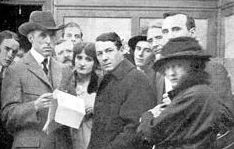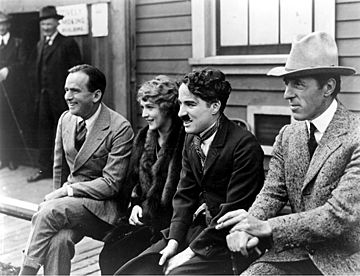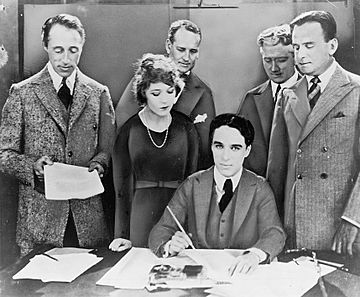D. W. Griffith facts for kids
Quick facts for kids
D. W. Griffith
|
|
|---|---|
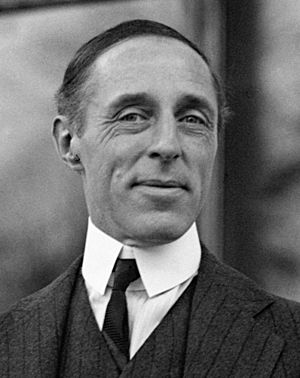
Griffith in 1922
|
|
| Born |
David Wark Griffith
January 22, 1875 Oldham County, Kentucky, U.S.
|
| Died | July 23, 1948 (aged 73) Hollywood, California, U.S.
|
| Resting place | Mount Tabor Methodist Church Graveyard, Centerfield, Kentucky, U.S. |
| Occupation |
|
| Years active | 1895–1931 |
| Spouse(s) |
Linda Arvidson
(m. 1906; div. 1936)Evelyn Baldwin
(m. 1936; div. 1947) |
| Signature | |
David Wark Griffith (born January 22, 1875 – died July 23, 1948) was an American film director. He is known as one of the most important people in movie history. He helped create many new ways to edit films and made movies tell stories in a more artistic way.
Griffith is most famous for directing the movie The Birth of a Nation (1915). This film made a lot of money, but it also caused a lot of arguments. Many people were upset because it showed African Americans in a bad way and made the Ku Klux Klan look like heroes. This view was seen as very unfair and racist. The movie led to protests in many cities across the United States. The National Association for the Advancement of Colored People (NAACP) even tried to get the film banned. Griffith made his next movie, Intolerance (1916), to respond to critics. He felt they were being unfair to his work.
In 1919, Griffith started a movie studio called United Artists with other famous people like Charlie Chaplin, Mary Pickford, and Douglas Fairbanks. Their goal was to let actors and directors make movies the way they wanted, instead of following big studio rules. Some of Griffith's later movies were popular, like Broken Blossoms (1919), Way Down East (1920), and Orphans of the Storm (1921). However, he often spent too much money making and promoting his films, which sometimes led to them not making a profit. By 1931, when he made his last movie, The Struggle, he had directed about 500 films. Almost all of them were silent movies.
Griffith's place in history is seen in different ways. During his life, many people admired him. Today, movie experts still recognize him for his new ideas in filmmaking. However, many critics, both then and now, have said that Griffith and his work, especially The Birth of a Nation, promoted ideas of white superiority. Historians often say that The Birth of a Nation played a big part in the Ku Klux Klan becoming strong again in the 1900s. The movie is still widely criticized today.
Early Life
David Wark Griffith was born on January 22, 1875. He grew up on a farm in Oldham County, Kentucky. His father, Jacob Wark "Roaring Jake" Griffith, was a colonel for the Southern states during the American Civil War. He also became a lawmaker in Kentucky. David's mother was Mary Perkins.
Griffith was raised as a Methodist. He went to a small, one-room school taught by his older sister, Mattie. When he was 10, his father died, and his family faced hard times financially.
When Griffith was 14, his mother moved the family to Louisville, Kentucky. She opened a boarding house there, but it did not do well. Griffith left high school to help his family. He took jobs in stores. He started his creative journey as an actor in traveling theater groups. He also tried to become a writer for plays, but he didn't have much success. Only one of his plays was ever performed.
In 1907, he went to New York City. He wanted to sell a script to Edison Studios producer Edwin S. Porter. Porter didn't buy his script, but he gave Griffith an acting part in a movie called Rescued from an Eagle's Nest. Because of this, Griffith decided to try acting in movies. He appeared as an extra in many films.
Early Film Career
In 1908, Griffith got a small acting role in a play for the American Mutoscope and Biograph Company. There, he met a camera operator named Billy Bitzer. This meeting changed his film career forever. In 1908, Biograph's main director became sick. His son took over, but he wasn't successful. So, Biograph's co-founder, Harry Marvin, gave Griffith the director job. Griffith made his first short film, The Adventures of Dollie. That year, he directed 48 short films for the company.
In 1909, he directed The Cricket on the Hearth, which was based on a novel by Charles Dickens. Griffith used a technique called cross-cutting in his films. This means showing two different scenes happening at the same time, just like Dickens did in his books such as Oliver Twist. When a camera operator questioned this in a later film, Griffith reportedly said, "Well, doesn't Dickens write that way?"
His short film In Old California (1910) was the first movie ever filmed in Hollywood, California. Four years later, he produced and directed his first long movie, Judith of Bethulia (1914). This was one of the first long movies made in the U.S. Biograph didn't think longer movies would work at that time. According to actress Lillian Gish, the company thought "a movie that long would hurt [the audience's] eyes."

Griffith left Biograph because the company didn't agree with his goals and because he spent too much money on his films. He took his group of actors with him and joined the Mutual Film Corporation. There, he helped produce The Life of General Villa. This was a silent movie about Pancho Villa, who played himself. It was filmed in Mexico during a civil war. Griffith then started a new studio with Majestic Studios manager Harry Aitken. This studio was first called Reliance-Majestic Studios and later Fine Arts Studios. His new company became an independent film-making group with the Triangle Film Corporation. This corporation was led by Aitken and his brother Roy.
In 1915, Griffith directed and produced The Clansman through Reliance-Majestic Studios. This film later became known as The Birth of a Nation. It was one of the first long American movies. The film was very successful, but it caused a lot of debate. This was because of how it showed slavery, the Ku Klux Klan, and the time after the American Civil War. The movie was based on a 1905 novel by Thomas Dixon Jr. called The Clansman: A Historical Romance of the Ku Klux Klan. It showed slavery in a positive light and made the Ku Klux Klan seem like heroes who were fixing things. This view was popular at the time, but groups like the National Association for the Advancement of Colored People (NAACP) strongly criticized it.
The NAACP tried to stop the movie from being shown. They succeeded in some cities, but the film was still shown widely. It became the most successful movie of its time. It is seen as one of the first "blockbuster" movies. It broke all previous box-office records. Lillian Gish said, "They lost track of the money it made."
In some big northern cities, audiences protested the movie's content and violence. Griffith was upset by attempts to censor or ban his film. This led him to produce Intolerance the next year. In this movie, he showed the effects of intolerance in four different historical times: the fall of Babylon, the crucifixion of Jesus, the killing of French Protestants (Huguenots), and a modern story. Intolerance did not make money. It didn't earn enough to cover the huge costs of making it. Griffith spent a lot of his own money on the film, which caused him financial problems for the rest of his life.
Griffith's film partnership ended in 1917. He then worked for Artcraft, which was part of Paramount Pictures, and later for First National Pictures (1919–1920). At the same time, he started United Artists with Charlie Chaplin, Mary Pickford, and Douglas Fairbanks. This studio was created to give actors more control over their own work.
He kept making movies, but he never again had films that earned as much money as The Birth of a Nation or Intolerance.
Later Film Career
Even though United Artists continued as a company, Griffith's time with it was short. While some of his later movies did well, he often didn't have big commercial successes. Some of Griffith's films from this time include Broken Blossoms (1919), Way Down East (1920), Orphans of the Storm (1921), Dream Street (1921), One Exciting Night (1922), and America (1924). The first three of these were successful. Griffith had to leave United Artists after Isn't Life Wonderful (1924) did not make money.
He made one movie with some sound, Lady of the Pavements (1929). He made only two full-sound films: Abraham Lincoln (1930) and The Struggle (1931). Neither of these movies was successful. After The Struggle, he never made another film.
In 1936, director Woody Van Dyke, who had learned from Griffith on Intolerance, asked Griffith to help film a famous earthquake scene for the movie San Francisco. Griffith was not given official credit for his work. This movie, starring Clark Gable, Jeanette MacDonald, and Spencer Tracy, was the highest-earning film of that year.
In 1939, producer Hal Roach hired Griffith to help produce Of Mice and Men (1939) and One Million B.C. (1940). Roach wrote to Griffith, saying he needed his help with writers, actors, and general supervision for these movies.
Griffith later disagreed with Roach about the production and left. However, Roach later said that Griffith directed some scenes in the finished film. If true, this would make it the last movie Griffith was actively involved in. But actors from the film remember Griffith only directing screen tests and costume tests. When Roach advertised One Million B.C. in late 1939 with Griffith listed as producer, Griffith asked for his name to be removed.
For many years, people in the film industry greatly respected Griffith. He received a special Oscar from the Academy of Motion Picture Arts and Sciences in the mid-1930s. In 1946, he made a surprise visit to the set of David O. Selznick's western movie Duel in the Sun. Some of his old actors, like Lillian Gish, Lionel Barrymore, and Harry Carey, were in the movie. Gish and Barrymore found their old mentor's presence distracting. Griffith then hid behind the scenery when they were filming their scenes.
Death
On the morning of July 23, 1948, Griffith was found unconscious in the lobby of the Hollywood Knickerbocker Hotel in Los Angeles. He had been living there alone. He died at 3:42 PM on the way to a Hollywood hospital from a brain bleed. A public memorial service was held for him at the Hollywood Masonic Temple. He is buried at Mount Tabor Methodist Church Graveyard in Centerfield, Kentucky. In 1950, The Directors Guild of America placed a stone and bronze monument at his grave.
Legacy
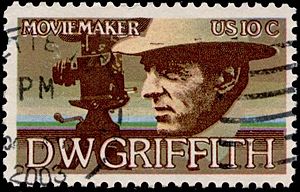
The famous performer and director Charlie Chaplin called Griffith "The Teacher of Us All." Many other filmmakers, including Alfred Hitchcock, Jean Renoir, Cecil B. DeMille, and Stanley Kubrick, have praised Griffith's work.
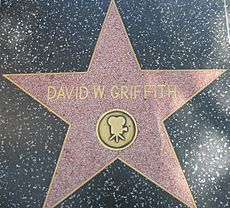
Griffith seems to have been the first to understand how certain film techniques could be used to create an expressive language. This became widely known with his movie The Birth of a Nation (1915). His early short films, like Biograph's The Musketeers of Pig Alley (1912), show that Griffith paid close attention to where the camera was placed and how lighting was used. This helped create mood and excitement. When making Intolerance, Griffith opened up new possibilities for movies. He created a film style that felt more like music than a traditional story.
- In 1951, an episode of The Philco Television Playhouse called "The Birth of the Movies" showed events from Griffith's film career. John Newland played Griffith.
- In 1953, the Directors Guild of America (DGA) created the D. W. Griffith Award, their highest honor. However, on December 15, 1999, the DGA announced that the award would be renamed the "DGA Lifetime Achievement Award." They said that even though Griffith was very talented, his film The Birth of a Nation "helped create terrible racial stereotypes." They felt it was better not to have their top award named after him.
- In 1975, the United States honored Griffith with a ten-cent postage stamp.
- The 1976 American comedy film Nickelodeon celebrates silent filmmakers and includes parts of The Birth of a Nation.
- D. W. Griffith Middle School in Los Angeles is named after Griffith.
- In 2008, the Hollywood Heritage Museum showed Griffith's earliest films to celebrate 100 years since he started in movies.
- On January 22, 2009, the Oldham History Center in La Grange, Kentucky, opened a 15-seat theater in Griffith's honor. The theater has a collection of Griffith's films.
Film Preservation
Six of Griffith's films are kept in the United States National Film Registry. These films are considered "culturally, historically, or aesthetically significant." They are Lady Helen's Escapade, A Corner in Wheat (both 1909), The Musketeers of Pig Alley (1912), The Birth of a Nation (1915), Intolerance (1916), and Broken Blossoms (1919).
See also
 In Spanish: D. W. Griffith para niños
In Spanish: D. W. Griffith para niños
- D. W. Griffith filmography
- D. W. Griffith House
- Griffith Ranch (in San Fernando, California)
- List of film directors who studied under D. W. Griffith
- List of Freemasons
- List of people from the Louisville metropolitan area



